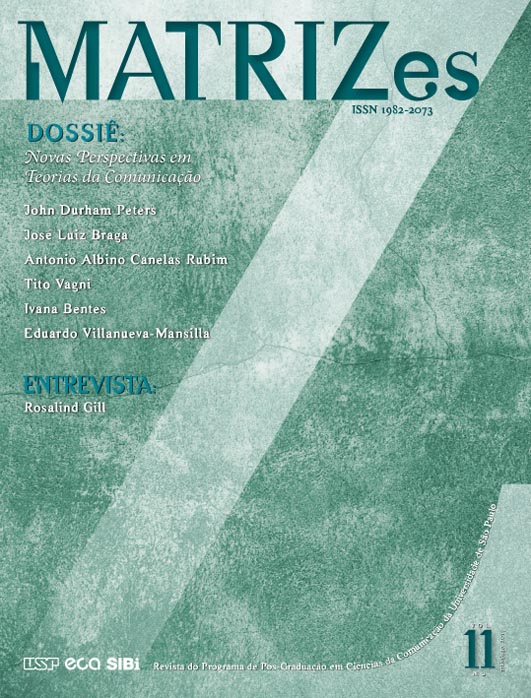Memes, menomes and LOLs: expression and reiteration through digital rhetorical devices
DOI:
https://doi.org/10.11606/issn.1982-8160.v11i2p111-133Parole chiave:
Memes, digital narratives, internet studies, communities of practiceAbstract
The popularity of internet memes as communication items presents a series of research issues, including the characteristics of any connection with the original meme concept from biology. Also, an aspect that demands exploration is how these items serve a broader communicative purpose, as mechanisms for individuals or groups, and how they impact society as a whole. This paper presents a revision of perspectives on memes, and proposes to analyze them as rhetorical devices, devising a general interpretation of these items as menomes, and concentrating attention in a particular iteration, the image macro meme, which we propose to call LOL.
Downloads
Riferimenti bibliografici
ARDICHVILI, A.; PAGE, V.; WENTLING, T. Motivation and barriers to participation in virtual knowledge-sharing communities of practice. Journal of Knowledge Management, Bingley, v. 7, n. 1, p. 64-77, 2003.
ATRAN, S. The trouble with memes: inference versus imitation in cultural creation. Human Nature, Nova Iorque, v. 12, n. 4, p. 351-381, 2001.
BAUCKAGE, C. Insight into internet memes. In: International AAAI Conference on Weblogs and Social Media, 5., Barcelona. Proceedings... Barcelona: Barcelona Media, 2011. p. 42-49Disponível em: <https://goo.gl/gPcyfc>. Acesso em: 27 jun. 2017.
BENNETT, W. L.; SEGERBERG, A. The logic of connective action. Information, Communication and Society, Abingdon, v. 15, n. 5, p. 739-768, 2012.
BERNSTEIN, M. et al. 4chan and /b/: An analysis of anonymity and ephemerality in a large online community. In: International AAAI Conference on Weblogs and Social Media, 5., cidade. Proceedings... Barcelona: Barcelona Media, 2011. p. 50-57. Disponível em: <https://goo.gl/wpfQoV>. Acesso em: 27 jun. 2017.
BOYD, D. It’s complicated: the social lives of networked teens. New Haven: Yale University Press, 2014.
BURMAN, J. T. The misunderstanding of memes: biography of an unscientific object, 1976-1999. Perspectives on Science, Cambridge, MA, v. 20, n. 1, p. 75-104, 2012.
CANNIZARO, S. Internet memes as internet signs: a semiotic view of digital culture. Sign Systems Studies, Tartu ,v. 44, n. 4, p. 562-586, 2016.
CHEN, C. The creation and meaning of internet memes in 4chan: popular internet culture in the age of online digital reproduction. Habitus, New Haven, v. 3, n. 3, p. 6-19, 2012.
COX, A. What are communities of practice? A comparative review of four seminal works. Journal of Information Science, Thousand Oaks, v. 31, n. 6, p. 527-540, 2005.
CRYSTAL, D. Txtng: the gr8 db8. Oxford: Oxford University Press, 2008.DAWKINS, R. The selfish gene. Oxford: Oxford University Press, 2006.
DOUGLAS, N. It’s supposed to look like shit: the internet ugly aesthetic. Journal of Visual Culture, Thousand Oaks, v. 13, n. 3, p. 314-339, 2014.
GERBAUDO, P. Protest avatars as memetic signifiers: political profile pictures and the construction of collective identity on social media in the 2011 protest wave, Information, Communication & Society, Abingdon, v. 18, n. 8, p. 916-929, 2015.
JENKINS, H.; FORD, S.; GREEN, J. Spreadable media: creating value and meaning in a networked culture. Nova Iorque: New York University Press, 2013.
Dowloads
Pubblicato
Fascicolo
Sezione
Licenza
Gli autori che pubblicano in questa rivista accettano i seguenti termini:
- Gli autori mantengono il copyright e concedono alla rivista il diritto alla prima pubblicazione, con il lavoro simultaneamente concesso in licenza in base alla Licenza di attribuzione Creative Commons (CC BY-NC-SA 4.0) che consente la condivisione dell'opera con riconoscimento di paternità e pubblicazione iniziale in questo giornale per scopi non commerciali.
- Gli autori sono autorizzati ad assumere contratti aggiuntivi separatamente, per la distribuzione non esclusiva della versione dell'opera pubblicata in questa rivista (ad esempio, pubblicazione in un archivio istituzionale o come capitolo di un libro), con riconoscimento di paternità e pubblicazione iniziale in questa rivista.






















